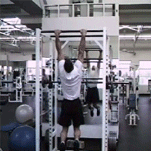Muscle-up


Muscle-up is a physical exercise that combines a pull-up with a dip. It is performed on gymnastics rings or a pull-up bar. The muscle-up is a complex, multi-joint movement that requires strength, power, and technique. It is often used in gymnastics, calisthenics, and CrossFit as a measure of upper body strength and skill.
Execution[edit]
The muscle-up begins with the athlete hanging from the rings or bar. The first phase is similar to a pull-up: the athlete pulls up, leading with their chest and keeping their elbows close to their body. As the athlete's chest reaches the level of the rings or bar, they transition to the second phase, which involves a rapid shift of the wrists and forearms from below the rings or bar to above. This transition is known as "the turnover." Once above the rings or bar, the athlete performs a dip, pushing themselves up until their arms are fully extended.
Technique and Training[edit]
Proper technique is crucial for successfully performing a muscle-up. Key components include:
- False Grip: On rings, a false grip (wrists positioned over the rings) can facilitate the transition phase.
- Pull-Up Strength: A strong pull-up foundation is essential. The pull should be explosive, bringing the athlete quickly to the transition phase.
- Dip Strength: The ability to perform a deep dip with control is necessary to complete the movement.
- Core Engagement: A tight core helps in maintaining body control throughout the exercise.
Training for a muscle-up often involves practicing its components separately before attempting the full movement. Exercises such as pull-ups, dips, and transitions drills are commonly used.
Benefits[edit]
The muscle-up works a wide range of muscle groups, including the latissimus dorsi, biceps, triceps, pectoralis major, and core muscles. It also develops intermuscular coordination, power, and agility.
Variations[edit]
Several variations of the muscle-up exist, including:
- Strict Muscle-up: Performed without any swinging or kipping motion, relying solely on strength.
- Kipping Muscle-up: Utilizes a swinging motion to generate momentum, making the exercise slightly easier.
- Ring Muscle-up: Performed on gymnastics rings, requiring more stability and control.
- Bar Muscle-up: Performed on a pull-up bar, often considered more challenging in the transition phase due to the fixed nature of the bar.
Challenges and Competitions[edit]
Muscle-ups are featured in various fitness competitions, including the CrossFit Games and gymnastics events. They are often used to test athletes' strength, endurance, and technique under pressure.
See Also[edit]
This exercise related article is a stub. You can help WikiMD by expanding it.
Ad. Transform your life with W8MD's Budget GLP-1 injections from $75


W8MD offers a medical weight loss program to lose weight in Philadelphia. Our physician-supervised medical weight loss provides:
- Weight loss injections in NYC (generic and brand names):
- Zepbound / Mounjaro, Wegovy / Ozempic, Saxenda
- Most insurances accepted or discounted self-pay rates. We will obtain insurance prior authorizations if needed.
- Generic GLP1 weight loss injections from $75 for the starting dose.
- Also offer prescription weight loss medications including Phentermine, Qsymia, Diethylpropion, Contrave etc.
NYC weight loss doctor appointmentsNYC weight loss doctor appointments
Start your NYC weight loss journey today at our NYC medical weight loss and Philadelphia medical weight loss clinics.
- Call 718-946-5500 to lose weight in NYC or for medical weight loss in Philadelphia 215-676-2334.
- Tags:NYC medical weight loss, Philadelphia lose weight Zepbound NYC, Budget GLP1 weight loss injections, Wegovy Philadelphia, Wegovy NYC, Philadelphia medical weight loss, Brookly weight loss and Wegovy NYC
|
WikiMD's Wellness Encyclopedia |
| Let Food Be Thy Medicine Medicine Thy Food - Hippocrates |
Medical Disclaimer: WikiMD is not a substitute for professional medical advice. The information on WikiMD is provided as an information resource only, may be incorrect, outdated or misleading, and is not to be used or relied on for any diagnostic or treatment purposes. Please consult your health care provider before making any healthcare decisions or for guidance about a specific medical condition. WikiMD expressly disclaims responsibility, and shall have no liability, for any damages, loss, injury, or liability whatsoever suffered as a result of your reliance on the information contained in this site. By visiting this site you agree to the foregoing terms and conditions, which may from time to time be changed or supplemented by WikiMD. If you do not agree to the foregoing terms and conditions, you should not enter or use this site. See full disclaimer.
Credits:Most images are courtesy of Wikimedia commons, and templates, categories Wikipedia, licensed under CC BY SA or similar.
Translate this page: - East Asian
中文,
日本,
한국어,
South Asian
हिन्दी,
தமிழ்,
తెలుగు,
Urdu,
ಕನ್ನಡ,
Southeast Asian
Indonesian,
Vietnamese,
Thai,
မြန်မာဘာသာ,
বাংলা
European
español,
Deutsch,
français,
Greek,
português do Brasil,
polski,
română,
русский,
Nederlands,
norsk,
svenska,
suomi,
Italian
Middle Eastern & African
عربى,
Turkish,
Persian,
Hebrew,
Afrikaans,
isiZulu,
Kiswahili,
Other
Bulgarian,
Hungarian,
Czech,
Swedish,
മലയാളം,
मराठी,
ਪੰਜਾਬੀ,
ગુજરાતી,
Portuguese,
Ukrainian